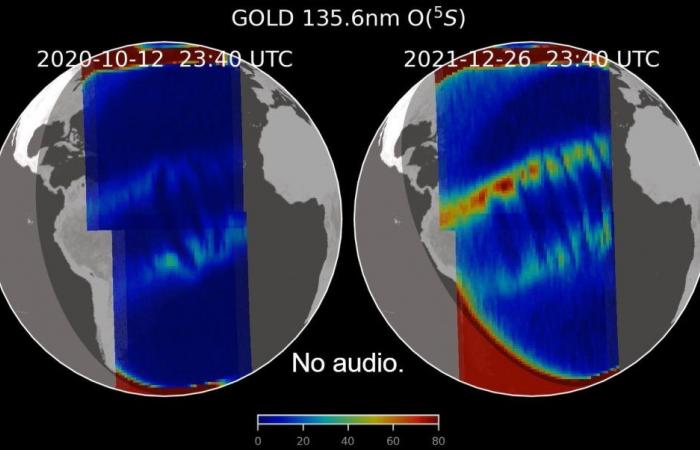NASA’s Global-scale Observations of the Limb and Disk (GOLD) mission has revealed unexpected C- and X-shaped formations in the electrified layer of gas that makes up the ionosphere.
Although these alphabetic shapes have been observed before, GOLD sees them more clearly than other instruments and now finds them where and when scientists didn’t expect. Their surprising appearances show that we have more to learn about the ionosphere and its effects on communications and navigation signals passing through it.
The ionosphere, which extends between 80 and 640 kilometers above our planet, becomes electrically charged during the day when sunlight hits our planet and its energy rips electrons from atoms and molecules. This creates a soup of charged particles, known as plasma, that allows radio signals to travel great distances.
Near Earth’s magnetic equator, charged particles funnel up and outward along magnetic field lines, creating two dense bands of particles north and south of the equator that scientists call ridges. As night falls and the Sun’s energy fades, pockets of low-density plasma, called bubbles, can form in the ionosphere. Due to their variable density, ridges and bubbles can interfere with radio and GPS signals.
While previous observations provided brief glimpses of ridges and bubbles in the ionosphere, GOLD monitors these features over long periods of time. This is due to its geostationary orbit, which rotates around our planet at the same rate as Earth, allowing GOLD to float above the Western Hemisphere.
The ionosphere is sensitive to disturbances from both space and Earth’s climate. GOLD has previously revealed that after a solar storm or large volcanic eruption, the ridges of the ionosphere can merge to form an X shape. But now, GOLD has seen an X shape form on multiple occasions when there were no such disturbances, what scientists call “quiet time.”
“Previous reports of mergers occurred only during geomagnetically disturbed conditions; it is an unexpected feature during calm geomagnetic conditions,” Fazlul Laskar of the Laboratory for Atmospheric and Space Physics (LASP) at the University of Colorado, who is the lead researcher, said in a statement. lead author of a paper on this discovery published by the Journal of Geophysical Research: Space Physics.
These unexpected appearances tell scientists that something else must be involved in the formation of these forms of X. Computer models suggest that the X could develop when changes in the lower atmosphere push plasma downward.
“The X is strange because it implies there are much more localized drivers,” said Jeffrey Klenzing, a scientist at NASA’s Goddard Space Flight Center who studies the ionosphere. “This is expected during extreme events, but seeing it during ‘quiet time’ suggests that lower atmosphere activity is significantly driving ionospheric structure.”
C-SHAPED BUBBLES INDICATE STRONG TURBULENCE
GOLD has also discovered surprising C-shaped plasma bubbles that indicate other puzzling dynamics influencing the ionosphere.
Most plasma bubbles appear long and straight, and form along magnetic field lines. But some bubbles are C-shaped and inverted C-shaped, which scientists believe are formed by Earth’s winds. Computer models suggest a C-shape forms if winds increase with altitude at the magnetic equator and an inverted C-shape if winds decrease with altitude.
“It’s a bit like a tree growing in a windy area,” Klenzing explains. “If the winds normally blow east, the tree starts to lean and grow in that direction.”
In a paper published in November 2023 in the Journal of Geophysical Research: Space Physics, LASP scientist Deepak Karan and colleagues report that GOLD has observed C-shaped and inverted C-shaped plasma bubbles that appear surprisingly close together, as close as about 600 kilometers away.
“At that close proximity, these two oppositely shaped plasma bubbles had never been thought of, had never been photographed,” Karan said. For wind patterns to change direction in such a small area, Karan thinks it’s likely that some kind of strong turbulence is at play in the atmosphere, such as a vortex, wind shear or tornado-like activity.
“The fact that we have very different shapes of bubbles so close together tells us that the dynamics of the atmosphere are more complex than we expected,” Klenzing said.
Such close pairings appear to be rare, with only two cases recorded by GOLD so far. However, as these features can disrupt critical communication and navigation technology, “it’s very important to figure out why this is happening,” Karan said. “If a very strong vortex or shear has occurred in the plasma, this will completely distort the plasma over that region. Signals will be completely lost with a strong disturbance like this.”






